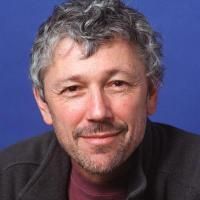Estimation of long-term basin scale evapotranspiration from streamflow time series
Date
2010-10-29
Journal Title
Journal ISSN
Volume Title
Repository Usage Stats
views
downloads
Citation Stats
Abstract
We estimated long-term annual evapotranspiration (ETQ) at the watershed scale by combining continuous daily streamflow (Q) records, a simplified watershed water balance, and a nonlinear reservoir model. Our analysis used Q measured from 11 watersheds (area ranged from 12 to 1386 km 2) from the uppermost section of the Neuse River Basin in North Carolina, USA. In this area, forests and agriculture dominate the land cover and the spatial variation in climatic drivers is small. About 30% of the interannual variation in the basin-averaged ETQ was explained by the variation in precipitation (P), while ETQ showed a minor inverse correlation with pan evaporation. The sum of annual Q and ETQ was consistent with the independently measured P. Our analysis shows that records of Q can provide approximate, continuous estimates of long-term ET and, thereby, bounds for modeling regional fluxes of water and of other closely coupled elements, such as carbon. Copyright 2010 by the American Geophysical Union.
Type
Department
Description
Provenance
Subjects
Citation
Permalink
Published Version (Please cite this version)
Publication Info
Palmroth, S, GG Katul, D Hui, HR McCarthy, RB Jackson and R Oren (2010). Estimation of long-term basin scale evapotranspiration from streamflow time series. Water Resources Research, 46(10). p. W10512. 10.1029/2009WR008838 Retrieved from https://hdl.handle.net/10161/4072.
This is constructed from limited available data and may be imprecise. To cite this article, please review & use the official citation provided by the journal.
Collections
Scholars@Duke

Sari Palmroth
Dr. Palmroth's research focuses on the effects of resource availability and climatic variability on carbon uptake and allocation of individual shoots, trees and forest ecosystems. She studies ecophysiological processes in trees from leaf to stand scales, with special emphasis on conifers. In particular, Dr. Palmroth is interested in the radiative transfer in forest canopies, how the radiation regime is affected by conifer shoot structure, and what the feedbacks are between availability of solar energy and allocation on carbon and nitrogen within canopies. She is also interested in how the carbon fixed in photosynthesis is allocated between above and belowground pools and what are the possible interaction effects on the allocation of the availabilities of nutrients and water and the level of atmospheric [CO2].

Gabriel G. Katul
Gabriel G. Katul received his B.E. degree in 1988 at the American University of Beirut (Beirut, Lebanon), his M.S. degree in 1990 at Oregon State University (Corvallis, OR) and his Ph.D degree in 1993 at the University of California in Davis (Davis, CA). He currently holds a distinguished Professorship in Hydrology and Micrometeorology at the Department of Civil and Environmental Engineering at Duke University (Durham, NC). He was a visiting fellow at University of Virginia (USA) in 1997, the Commonwealth Science and Industrial Research Organization (Australia) in 2002, the University of Helsinki (Finland) in 2009, the FulBright-Italy Distinguished Fellow at Politecnico di Torino (Italy) in 2010, the École polytechnique fédérale de Lausanne (Switzerland) in 2013, Nagoya University (Japan) in 2014, University of Helsinki (Finland) in 2017, the Karlsruher Institute for Technology (Germany) in 2017, Princeton University (USA) in 2020, and CzechGlobe (Brno - Czech Republic) in 2023. He received several honorary awards, including the inspirational teaching award by the students of the School of the Environment at Duke University (in 1994 and 1996), an honorary certificate by La Seccion de Agrofisica de la Sociedad Cubana de Fisica in Habana (in 1998), the Macelwane medal and became thereafter a fellow of the American Geophysical Union (in 2002), the editor’s citation for excellence in refereeing from the American Geophysical Union (in 2008), the Hydrologic Science Award from the American Geophysical Union (in 2012), the John Dalton medal from the European Geosciences Union (in 2018), and the Outstanding Achievements in Biometeorology Award from the American Meteorological Society (in 2021) and later became an elected fellow of the American Meteorological Society (in 2024). Katul was elected to the National Academy of Engineering (in 2023) for his contributions in eco-hydrology and environmental fluid mechanics. He served as the Secretary General for the Hydrologic Science Section at the American Geophysical Union (2006-2008). His research focuses on micro-meteorology and near-surface hydrology with emphasis on heat, momentum, carbon dioxide, water vapor, ozone, particulate matter (including aerosols, pollen, and seeds) and water transport in the soil-plant-atmosphere system as well as their implications to a plethora of hydrological, ecological, atmospheric and climate change related problems.

Ram Oren
With his graduate students, Oren quantifies components of the water cycle in forest ecosystems, and their responses to biotic and abiotic factors. Relying on the strong links between the carbon and water cycles, he also studies the components of the carbon flux and their response to these factors. Climate variability, including variations in air temperature, vapor pressure deficit, incoming radiation and soil moisture, and environmental change, including elevated atmospheric carbon dioxide, affect the intra- and inter-annual dynamics, and amounts of water used by forest ecosystems, and their spatial distribution, as well as carbon uptake and sequestration. In turn, the variation of water flux influence the temporal and spatial partitioning of incoming radiation between latent and sensible heat. The flow of water from soil through plant leaves into the atmosphere, and the exchange of water for CO2 absorbed from the atmospheric, are among the processes theoretically best understood in plant and ecosystem physiology. Using these theories, local mass balance approaches, and detailed measurements of water and carbon flux and driving variables in the soil, plants, and the atmosphere, Oren has been attempting to predict the likely responses of forest ecosystems, from the equator to the arctic circle, to environmental change and management.
Unless otherwise indicated, scholarly articles published by Duke faculty members are made available here with a CC-BY-NC (Creative Commons Attribution Non-Commercial) license, as enabled by the Duke Open Access Policy. If you wish to use the materials in ways not already permitted under CC-BY-NC, please consult the copyright owner. Other materials are made available here through the author’s grant of a non-exclusive license to make their work openly accessible.
